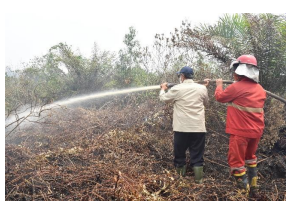The Economic Impact of The Implementation of The Lucky Waste Program in the Oyster Mushroom Cultivation Farmer Group of Payakabung Village, North Indralaya Sub-District, Ogan Ilir District

Submission to VIJ 2024-07-28
Keywords
- Corporate Social Responsibility (CSR), Bertuah Waste Program, Palm Frond Waste, Baglog Waste
Copyright (c) 2024 Saddam Husein, Abdul Roni Heryanto, Kurniawan Bagus Dwi Prayogo, Muhammad Ichsan Hadjri

This work is licensed under a Creative Commons Attribution 4.0 International License.
Abstract
This study aims to determine and analyze the economic impact of the implementation of the Bertuah Waste Program in the Oyster Mushroom Farmer Group of Payakabung Village, North Indralaya District, Ogan Ilir Regency. The Bertuah Waste Program is a flagship Corporate Social Responsibility (CSR) program of PT PLN Indonesia Power UBP Keramasan UP Indralaya. This program aims to have an impact on improving the community's economy and as a form of effort to overcome environmental problems around Payakabung Village, such as the generation of palm frond waste which is a factor in the severe condition of forest and land fires, as well as the generation of baglog waste which is used as liquid smoke. The method used in this research is a qualitative approach with a descriptive method. The results showed that the Bertuah Waste Program is a form of development and innovation from oyster mushroom cultivation activities in Payakabung Village which has been running since 2022. The Bertuah Waste Program has shown impacts, both in terms of economy and environment for the community, especially members of the Oyster Mushroom Farmer Group and Srikandi Payakabung. The economic impact is shown in the form of savings in raw material costs, savings in vegetable pesticide costs, and increased income for group members.
References
- Bahrri , S., and Panorama, M. (2021). Implementation of Sharia Business Ethics in Micro, Small and Medium Enterprises ( Mumkm ) During the Covid-19 Pandemic at the Self-Help Mutual Cooperation Market in the Batumarta Community, Baturaden Village Subdistrict Lubuk Raja, Ogan Komering Ulu Regency . Raden Fatah State Islamic University: Journal of Islamic Studies Volume 17 Number 2.
- Dessy . (2022). Implementation of the Mitigation Program Poverty through Social Assistance in Parit Village Subdistrict North Indralaya, Ogan Ilir Regency . Thesis . Major Sociolophy Faculty Social Sciences and Science Politics : Sriwijaya University .
- Girsang , SH (2022). Impact Coconut Plantation Fire Palm to Diversity of Mammal Types : Case Study of PT RAJ South Sumatra. Journal Forest Research and Nature Conservation Volume 19 Number 2.
- Mardalena , SS, and Akmal. (2016) Effects Giving Midrib Fermented Palm Oil with Prolinas to Rumen Characteristics of PFH Dairy Cows . Faculty Jambi University Animal Husbandry : Journal Sciences Animal Husbandry Volume 19 Number 2.
- Moleong , L. J. (2017). Research methods Qualitative . Bandung: PT. Teenager Rosdakarya .
- Widjajanti , K. (2011). Community Empowerment Model . Semarang University Faculty of Economics: Journal of Development Economics Volume 12 Number 1.
- Zainuri , et al . (2019). Subtraction CO2 emissions with Utilization Waste Midrib Coconut Palm Oil in Production Fiber Bricks . Lancang Kuning University : Journal Technology Environment Volume 20 Number 1.
- Other Sources
- Law of the Republic of Indonesia Number 40 of 2007 concerning Limited Liability Companies
- Internet
- Central Bureau of Statistics Ogan Ilir Regency . (2023). Amount Poor Population ( Thousand People) According to Regency /City Year 2021 - 2023. https://oganilirkab.bps.go.id/indicator/23/205/1/nomor-penbangun-miskin.html
- Central Bureau of Statistics Ogan Ilir Regency . (2019). Area and Production Plant Coconut People's Palm Oil According to Subdistricts in Ogan Ilir Regency 2014. https://oganilirkab.bps.go.id/statictable/2016/03/21/28/lebar-areal-dan-produk-tanaman-kelapa-sawit-rakyat-menrut-kecamatan-di -ogan-ilir-2014.html